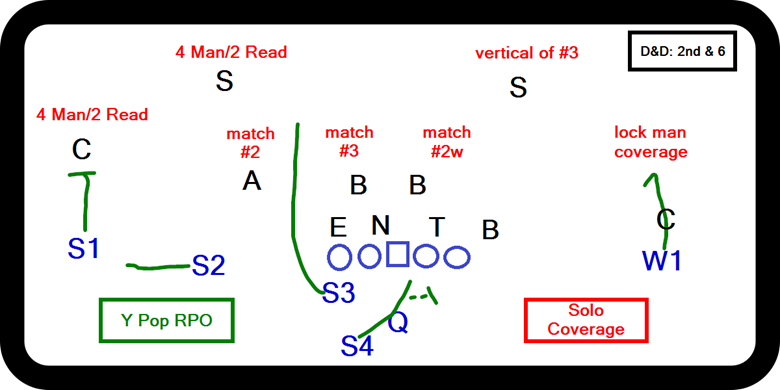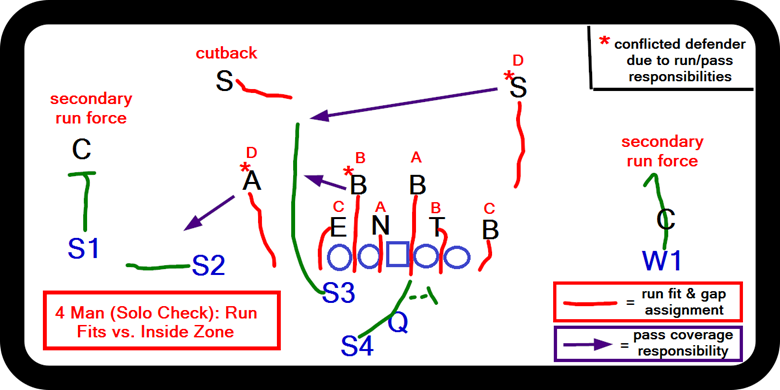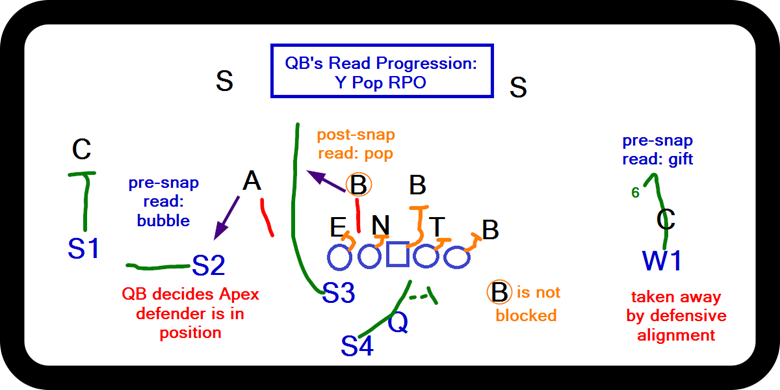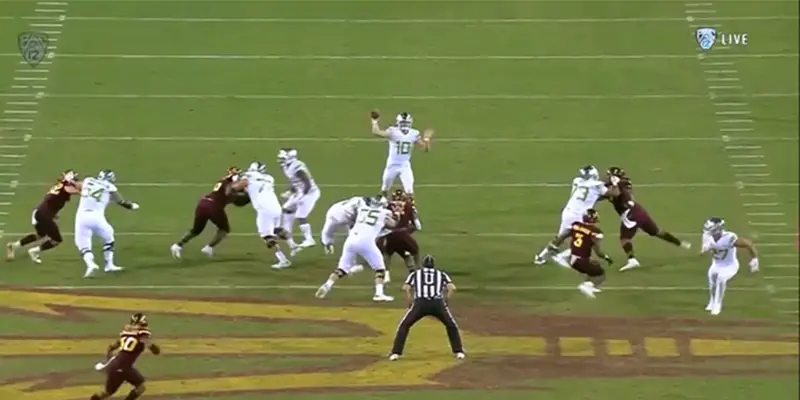Welcome to this week’s edition of X’s vs. O’s! Today, we will be discussing one of the ways the Ducks exploit defenders’ simultaneous run/pass responsibilities. The example today is an RPO concept Oregon used in their game against Arizona State.
“RPO” stands for Run-Pass Option. On an RPO, the play is set up as a run, but the Quarterback (QB) has one or more passing options in addition to the ability to execute the called run concept. The QB evaluates the alignment and/or reaction of the defense to decide which option is best.
There are three types of RPO plays. With a pre-snap RPO, the QB bases his decision on the initial pre-snap alignment of the defense. With a post-snap RPO, the QB makes his decision by reading the reaction of a specific unblocked defender.
We’re going to talk about the third type, which provides the QB with both a pre-snap and post-snap option. The “Y Pop” RPO is an example of this type; see the diagram below for an illustration.

Basic Assignments
Oregon deploys a “4 Strong” formation in this 2nd-and-6 situation. Arizona State responds with a common formation check, known as “Solo.”
Solo coverage allows the defense to maintain their base coverage structure to the strength of the formation, and recruits the weak safety to the strong side to provide additional help in the middle of the field.
The weak safety will “cross key” the S3 and cover him on any vertical route. In order to accomplish this, the weak side cornerback (CB) is left in one-on-one man coverage with the W1 receiver.
Take special note of the linebacker (match #3 in diagram) and the safety (vertical of #3 in diagram). On this play, these two are responsible for covering S3. This means that S3 should be bracketed by the these two defenders since the S3 is releasing vertically up the field. Keep this in mind as we continue.

Conflicted defenders’ run-fits and pass coverage responsibilities
In the above diagram, you will notice how the three highlighted defenders (*) are conflicted due to the combination of their run-fit assignment and their pass-coverage assignment.
The Y Pop RPO is designed to attack “the space left behind”. Since a defender can only be in one place at a time, the offense can read his reaction to best attack the weakness of the defense.

QB’s pre-snap and post-snap read progressions
The above diagram illustrates the QB’s thought process as he surveys the defense. In our example, the QB has eliminated both pre-snap pass options.
After securing the snap, the QB is reading the highlighted (orange circle) linebacker to decide whether he is going to hand the ball off to the running back or pull and throw the ball to the S3 receiver. Regardless of his decision, the offensive line always blocks the designed run play.
Now, let’s see the play in living color:
Example from the Game: Why and How Did/Didn’t It Work?
This clip is a perfect example of what the Y Pop RPO is designed to accomplish. The strong side LB (#3) aggressively attacks the line of scrimmage to fit the “B” gap per his run fit assignment. This provides the QB with an easy read and a nice throwing window.
The weak side safety (#30) was held just long enough by the run action and his gap responsibility to allow for an easy pitch-and-catch.
The end result was a missed open field tackle and an explosive play for the Oregon offense. An athlete one-on-one in space against a secondary defender — exactly the matchup the modern spread offense looks to create.
RPO-based spread offenses force the defense to cover the entire field — both vertically and horizontally.
Giving the QB multiple options to choose from, based on the lineup and/or reactions of the defense, allows the offense to more specifically exploit the “holes” in the defense.
The Taggart Oregon offense is predicated on this very principle. Football is a numbers game at its core, and modern offenses are designed to play with loaded dice.
Zach Pierson
Birmingham, Alabama
Top Photo from Video
Zach enjoys dissecting football gameplans and schemes from the confines of his home office on the outskirts of Birmingham, Alabama. His goal is to provide breakdowns that shed light on the intricacies of football, using simple, easy-to-understand language.

